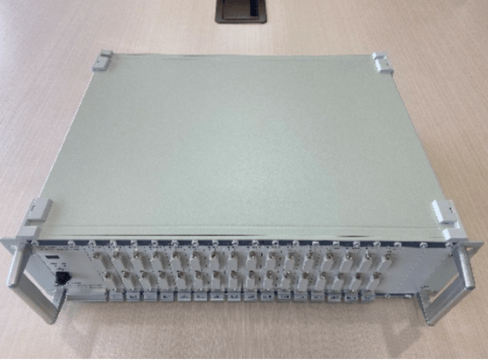Flight Load Testing of the AG600 Amphibious Aircraft
In March 2024, a user employed 18 SE-98 Dynamic Stress-Strain Testing and Analysis Systems to conduct flight load testing on the AG600 aircraft.
Over 2,000 strain measurement points were installed on the AG600 airframe to assess the structural load distribution and stability under various flight conditions.
Technical Analysis of the Testing Process
1. Test System Configuration
SE-98 System Capabilities: The 18 SE-98 dynamic stress-strain systems operated in parallel, requiring a high sampling rate (≥1 kHz) and 24-bit ADC resolution to capture microsecond-level strain fluctuations caused by aerodynamic loads. The system utilized IEEE 1588 Precision Time Protocol (PTP) to ensure synchronization errors remained <1 μs across all devices.
Sensor Network: The 2,000+ strain gauges were configured in full-bridge setups with temperature compensation for -40°C to +80°C (covering high-altitude and water-surface conditions). Critical areas (e.g., wing roots, keel beams) had a 5-10 sensors/m² density, with rosette strain gauges for multi-axis stress measurement.
2. Test Conditions & Flight Profiles
Water-Takeoff/Landing Tests: Included taxiing (0-100 km/h), wave impacts (0.5-1.5 m wave height), and landing shocks (sink rate ≤3 m/s). Special attention was given to dynamic stress concentrations at the float-fuselage junctions.
Flight Maneuvers:
Climb (15° pitch)
Cruise (280 km/h indicated airspeed)
45° banked turns (measuring wing torque distribution)
Strain data was used to reconstruct shear/bending moment diagrams and validate against theoretical models.
3. Data Fusion & Structural Analysis
Finite Element Model Updating (FEMU) was applied to minimize residual errors (<5%) between measured strain fields and ANSYS simulations. High-discrepancy zones (e.g., rear fuselage skin) were remeshed to 10mm resolution.
Modal Assurance Criterion (MAC) verified flutter margins, ensuring <3% deviation in the first bending mode (6-8 Hz) from design values.
4. Real-Time Safety Monitoring
A three-tier warning system triggered alerts if any strain exceeded 60% of yield limit (280 με for LY12CZ aluminum alloy).
Asymmetric loading (e.g., >15% wing strain imbalance) prompted immediate test termination.
Data & Future Applications
The test generated ~20 TB of raw data, enabling deep learning-based strain field prediction (3D-CRNN models) for future aircraft like the MA700. Results will directly impact the AG600’s final 4.5-ton payload certification.
This large-scale validation ensures the AG600 meets structural safety standards for both maritime rescue and firefighting missions.


